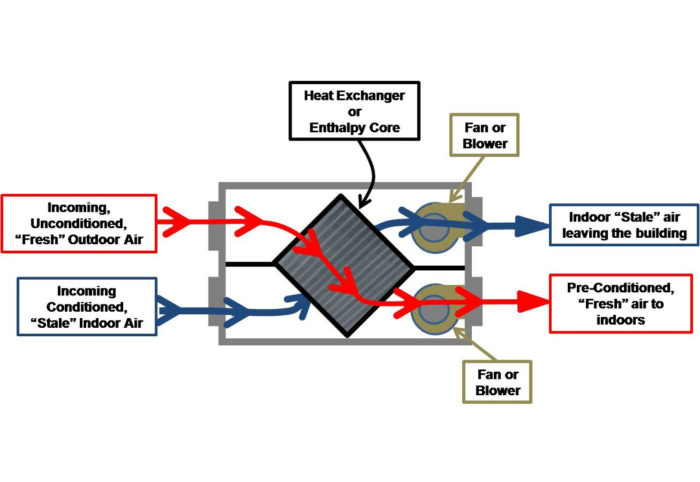How HRV Improves Indoor Air Quality and Better Breathing
Discovering the Benefits of Heat Recovery Ventilation for Power Performance in Homes
Heat Recovery Ventilation (HRV) systems offer property owners a functional method to improving energy effectiveness. By redeeming warmth from outgoing air, these systems can considerably reduce home heating and cooling costs. Furthermore, they provide a steady supply of fresh air, boosting indoor air top quality and comfort degrees. As house owners take into consideration lasting alternatives, understanding the subtleties of HRV systems becomes increasingly crucial. What factors should one evaluate prior to making such an investment?
Recognizing Heat Recovery Ventilation Solutions

Just How HRV Boosts Indoor Air Top Quality

Power Financial Savings: The Economic Benefits of HRV
Optimizing power effectiveness, heat recovery ventilation (HRV) systems provide substantial financial advantages for homeowners. By recovering and reusing warmth from exhaust air, HRVs markedly minimize heating & cooling expenses. This modern technology can cause energy savings of approximately 30%, depending on environment and use patterns. Home owners frequently see lowered utility expenses soon after setup, making HRVs a monetarily smart financial investment gradually. Additionally, numerous areas offer rewards or discounts for energy-efficient upgrades, better improving the economic allure. As power prices remain to climb, the cost-effectiveness of HRVs comes to be progressively clear. On the whole, the unification of HRV systems not only advertises energy effectiveness but likewise adds to lasting monetary cost savings for families.
The Environmental Impact of Heat Recovery Ventilation
A substantial ecological advantage of heat recovery ventilation (HRV) systems hinges on their capability to decrease general energy intake. By recovering warmth from exhaust air and moving it to inbound fresh air, HRV systems minimize the need for energy-intensive heating and cooling approaches. This decrease in energy need adds to reduce greenhouse gas emissions, as much less fossil gas is called for to keep comfy interior temperature levels. In special info addition, HRV systems improve indoor air quality by effectively exchanging stagnant air with fresh outside air, lowering dependence on mechanical cooling systems that can damage the setting. Overall, the application of HRV systems supports lasting living techniques and straightens with worldwide initiatives to deal with environment modification by advertising power effectiveness in residential settings.
Choosing the Right HRV System for Your Home
Just how can homeowners assure they select the ideal heat recovery ventilation (HRV) system for their needs? They should evaluate their home's size and layout, as these factors affect airflow needs. Next, reviewing the system's Full Report efficiency scores is important, as higher rankings suggest much better performance and power cost savings. Home owners ought to likewise take into consideration installment and upkeep costs, comparing different brand names and designs for worth. Additionally, it's essential to evaluate sound levels, as some systems operate more silently than others. Consulting with heating and cooling specialists can offer customized suggestions based on specific home problems. Lastly, checking out user testimonials and service warranties can help in making an informed decision, making sure that the picked HRV This Site system successfully enhances indoor air high quality and power performance.
Often Asked Concerns

How Often Should I Clean or Maintain My HRV System?
The regularity of cleansing or keeping a heat healing ventilation (HRV) system normally relies on usage and ecological factors. Typically, it is a good idea to do upkeep every six months to guarantee peak performance and air high quality.

Can HRV Systems Assist Lower Humidity Degrees Inside Your Home?
HRV systems can successfully reduce indoor humidity degrees by exchanging stale, damp air with fresh, drier air from outdoors. HRV Heat Recovery Ventilation. This procedure aids maintain a well balanced interior atmosphere, improving convenience and stopping moisture-related problems
What Is the Life-span of a Common HRV System?
The lifespan of a normal heat recovery ventilation (HRV) system differs, typically lasting in between 10 to 15 years. Regular upkeep can extend its efficiency and operational life, guaranteeing peak performance throughout its usage period.
Exist Any Type Of Sound Interest In HRV Solutions?
Noise interest in HRV systems can emerge, especially from follower procedure. Several modern-day systems are developed to lessen audio degrees, ensuring they run quietly while keeping performance, which deals with prospective disturbances in living settings.
Can I Mount an HRV System Myself, or Do I Need a Professional?
The specific contemplated whether to install the heat recovery ventilation (HRV) system personally or hire a specialist. Typically, while do it yourself installation is feasible, experience assurances appropriate capability and compliance with local building codes, boosting system performance.